Общи словообразувателни модели в турския език и урду в контекста на езиковото взаимодействие
Common word-formating models in Turkish and Urdu in the context of linguistic interactions
Author(s): Miyryam Salim, Aydzhan PenevaSubject(s): Language and Literature Studies, Theoretical Linguistics, Lexis
Published by: Шуменски университет »Епископ Константин Преславски«
Keywords: word-formating models; Turkish; Urdu; affixes; derivative words
Summary/Abstract: In its development every society for various reasons establishes contacts with neighboring and non-neighboring nations, which undoubtedly leads to the phenomena of cultural and linguistic interaction. Research, collection, systematization and analysis of different types of lexical borrowings as a result of language contacts and interactions is particularly important for identifying, defining and clarifying the genesis or ethnolinguistic identity of the holders of a language as a whole, or of any territorial ethnographic part of it; history of the language itself, the origin and composition of its vocabulary, dialectal division and the main features of the dialects, history of one or another linguistic phenomenon and others. Languages, which have left traces in Urdu and Turkish at different levels and integrated to varying degrees into them, determine the need to address existing common lexical elements and their word formation. Subject of this research is the total word- formation models (Arabic and Persian) in the Ottoman (Turkish) language and Urdu. The focus is on word- formation models and affixation, their origin, their phonetic features, productivity and unproductivity of affixes, their semantics and examples of the derivative words in both languages.
Journal: Годишник на Шуменския университет "Епископ Константин Преславски". Факултет по хуманитарни науки
- Issue Year: XXVII/2016
- Issue No: 1
- Page Range: 99-105
- Page Count: 7
- Language: Bulgarian

